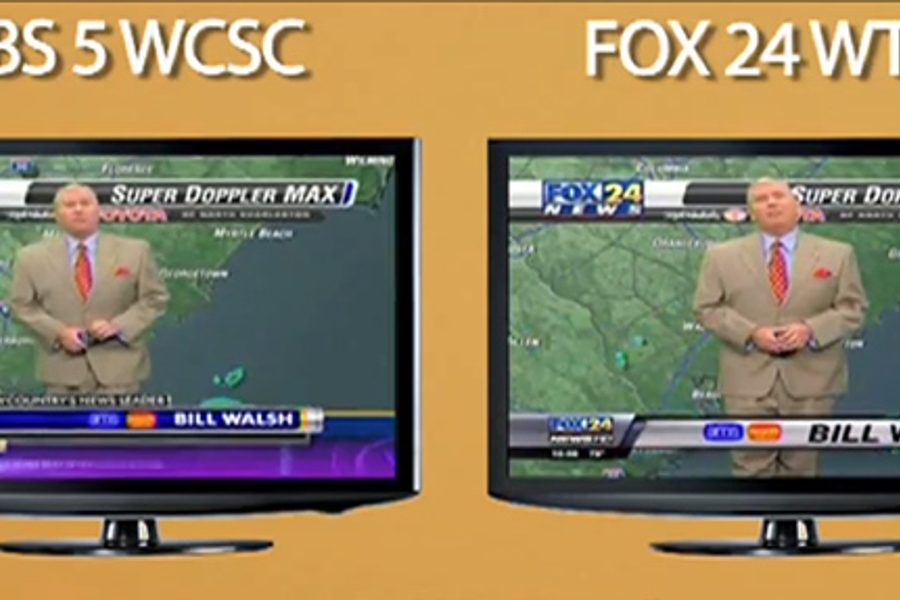
Free Press ties station layoffs to ‘covert consolidation’
While meeting with journalism students in Boulder, Colo., this month, Free Press president and CEO Craig Aaron played a collage of videos wherein the same newscasters delivered the same local news with only one significant difference — the station names at the bottom of the screen. Aaron said this is an example of “covert consolidation” — a trend quietly sweeping newsrooms in small towns and major cities that has cost journalists’ jobs, degraded their working conditions and gutted the quality and quantity of local news available to the public.
In the interest of the bottom line, TV news stations are increasingly sharing reporters and content. Mass corporate media consolidation that drove huge protests and outcry a decade ago seems to have dropped down in the priority list of free speech and independent media activists in recent years, as the explosion of blogs and new media startups has offered democratized and decentralized platforms with the potential to subvert and bypass mainstream media. But Aaron, a former In These Times managing editor who has worked for the nonprofit media reform advocacy group since its inception, cited studies showing a majority of Americans still rely on TV news for information.
So the consolidation of TV news stations on the corporate and/or editorial sides should be reason for concern for the same reasons overall media consolidation sparked massive protest in years past. As part of the larger consolidation trends, local TV news stations have been consumed by larger companies that bring increasing numbers of outlets under one umbrella.
And even in lieu of such corporate consolidation, Aaron noted, stations are making deals to share reporters and editorial content to cut costs. The most extreme form of consolidation is known as a “shared services agreement,” wherein one newsroom with one staff provides content for two or more stations – which presumably in the past had their own newsrooms and staff.
So in a profession wracked by job losses, “covert consolidation” has added to the carnage. Aaron listed a sample of local broadcast jobs lost: 68 in Honolulu, 30 in Peoria, 45 in Syracuse, 24 in Salt Lake City. He told In These Times:
“That’s the point of these shady deals. Cut staffs, shave costs, all the while raking in ad dollars alongside local newscasts. This attack on working journalists, broadcast engineers, even the ad department, is the reason why, among the leading opponents of covert consolidation, are unions like the Newspaper Guild and the National Association of Broadcast Employees and Technicians (NABET).”
Aaron added that a “smaller staff means a heavier workload, though I think the biggest problem is the stories we’re missing out on. Without journalists competing and digging up stories, political scandal or corporate corruption go completely undetected.”
Free Press, which is based in Washington D.C., launched its campaign around covert consolidation in June. It includes in-depth profiles of some markets on its website. Of Syracuse, it says:
In Syracuse, five TV stations are operated by just two companies: Barrington Broadcasting and Sinclair Broadcasting. Barrington owns WSTM and WSTQ and controls Granite Broadcasting owned former rival WTVH. The studios, staff, operations and branding for all three stations have been brought under a single umbrella branded “CNY Central.” Across town, WNYS and WSYT also share studios and produce a single newscast. Due to these covert operations, Syracuse suffers from a higher degree of media consolidation than almost any other market in the country.
A press release from the Free Press notes that
In most cases, these partnerships are established through deals that circumvent the Federal Communication Commission’s media ownership limits, while producing exactly the sorts of results the FCC rules are meant to help avoid: a decrease in competition, diversity and localism.
A map on its website shows which markets have been hardest hit by the trend, showing particular prevalence in the Midwest and southeast.
For example: “Peoria, Illinois is suffering from one of the worst cases of covert consolidation in the country; all five of its commercial TV stations produce just two distinct newscasts and are controlled by only two companies. Three of those stations, WEEK, WHOI and WAOE, are part of an anti-competitive conspiracy that spans two states.”
Kari Lydersen is a Chicago-based journalist, author and assistant professor at Northwestern University, where she leads the investigative specialization at the Medill School of Journalism, Media, Integrated Marketing Communications. Her books include Mayor 1%: Rahm Emanuel and the Rise of Chicago’s 99%.







